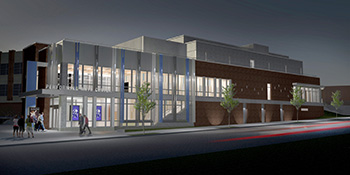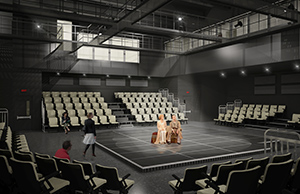Wagner High School to Build Performing Arts Center
 STATEN ISLAND, N.Y. — Construction on new classrooms, academic spaces and a performing arts center at Susan E. Wagner High School in Staten Island will be completed just in time for the 2016 school year. The new 28,000-square-foot performing arts center project addresses an overcrowding issue at Wagner High School and will bring the school in line with modern education standards. The project aims to integrate and balance the needs and requirements of the NYC School Construction Authority, the Susan Wagner Performing Arts Committee and the Staten Island Borough President’s Office. The NYC School Construction Authority, based in Long Island City, N.Y., is responsible for the construction and renovation of all New York City schools.
STATEN ISLAND, N.Y. — Construction on new classrooms, academic spaces and a performing arts center at Susan E. Wagner High School in Staten Island will be completed just in time for the 2016 school year. The new 28,000-square-foot performing arts center project addresses an overcrowding issue at Wagner High School and will bring the school in line with modern education standards. The project aims to integrate and balance the needs and requirements of the NYC School Construction Authority, the Susan Wagner Performing Arts Committee and the Staten Island Borough President’s Office. The NYC School Construction Authority, based in Long Island City, N.Y., is responsible for the construction and renovation of all New York City schools.
The Susan Wagner Performing Arts Committee is part of a school program, which fosters education and preparation for aspiring actors and performers. The school offers academic space, workshops, and teachers and staff that help students go on to explore theater and the performing arts.
Designers from di Domenico + Partners LLP, headquartered in Long Island City, N.Y., were contracted by the NYC School Construction Authority to design the project. Construction for the $25 million project is forecast to be complete for September 2016 occupancy. Currently, construction is running smoothly and on schedule, according to Andrew Berger, partner, di Domenico + Partners LLP.
“The project started several months ago, and we are completing foundation work and awaiting steel frame to be delivered to the site,” said Berger in June.
“The existing school has a full auditorium and other classrooms, but the intent of this project was to build a performing arts center that would address the needs of not only performing arts in terms of the space, but also in terms of classrooms, practice rooms, shops and other spaces where students can not only prepare for these events, but also learn the skill set throughout the entire process, such as creating props and other elements,” Berger continued.
 The project will provide an independently operational black box performance space will house rehearsals and specialty performances in a multipurpose venue with the requisite support, practice and storage spaces. The flexible performance space will support varied performance styles and seats 200.
The project will provide an independently operational black box performance space will house rehearsals and specialty performances in a multipurpose venue with the requisite support, practice and storage spaces. The flexible performance space will support varied performance styles and seats 200.
The new performing arts center will span three floors and be connected by a breezeway to the main building. In essence, though, it’s a standalone building, according to Berger. “This provides not only the opportunity to be a support to the high school but also the opportunity to have its own identity to the community. Part of the project was also to create a dual use so that the center could be used after hours not only as a performance space for the students, but also as a space for the community to use for functions,” Berger said. “It allows for flexible use for different venues — musical, theatrical, dance or experimental types of performing arts as well. It could also be used as a classroom, a practice space or as a performance space, and it allows for the community to use it for similar types of activities or general community meetings.”
The center’s design also includes a stage that can be moved and modified in terms of its shape and size, to accommodate other types of use. Theatrical lighting and acoustics as well as flexible seating will give the students the experience of working in a professional space.
The design and construction for the new performing arts center aims to meet high green building standards and will exceed compliance with the New York City Green School rating system’s requirements. It will make use of daylighting and include many state-of-the-art features, such as a high performance envelope, chilled beams, highly efficient cooling and heating systems, and xeriscaping.
A goal for the project was also to provide facilities that will support both learning and teaching. “We always study precedents as well as how to design facilities not only to support teaching and learning, but also to inspire and be the best that they could be in terms of technology and program,” Berger said.
This article originally appeared in the September/October issue of School Construction News.
